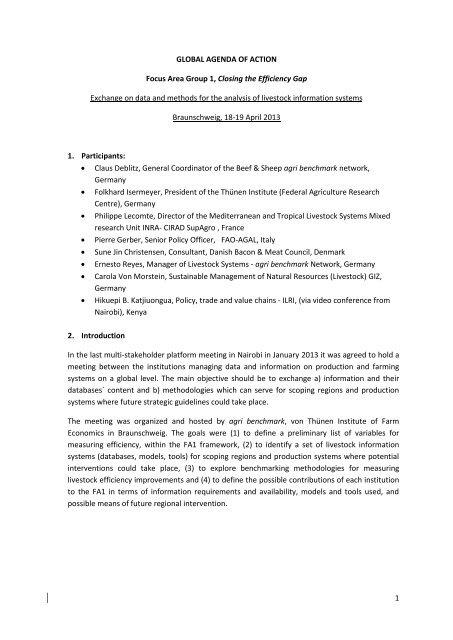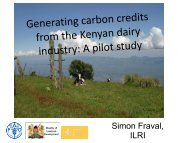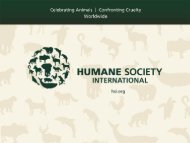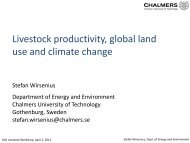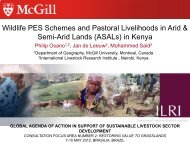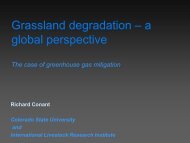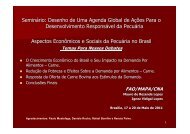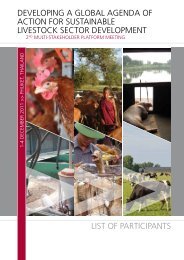Guiding Group meeting minutes - Global Agenda of Action for ...
Guiding Group meeting minutes - Global Agenda of Action for ...
Guiding Group meeting minutes - Global Agenda of Action for ...
You also want an ePaper? Increase the reach of your titles
YUMPU automatically turns print PDFs into web optimized ePapers that Google loves.
GLOBAL AGENDA OF ACTIONFocus Area <strong>Group</strong> 1, Closing the Efficiency GapExchange on data and methods <strong>for</strong> the analysis <strong>of</strong> livestock in<strong>for</strong>mation systemsBraunschweig, 18-19 April 20131. Participants:Claus Deblitz, General Coordinator <strong>of</strong> the Beef & Sheep agri benchmark network,GermanyFolkhard Isermeyer, President <strong>of</strong> the Thünen Institute (Federal Agriculture ResearchCentre), GermanyPhilippe Lecomte, Director <strong>of</strong> the Mediterranean and Tropical Livestock Systems Mixedresearch Unit INRA- CIRAD SupAgro , FrancePierre Gerber, Senior Policy Officer, FAO-AGAL, ItalySune Jin Christensen, Consultant, Danish Bacon & Meat Council, DenmarkErnesto Reyes, Manager <strong>of</strong> Livestock Systems - agri benchmark Network, GermanyCarola Von Morstein, Sustainable Management <strong>of</strong> Natural Resources (Livestock) GIZ,GermanyHikuepi B. Katjiuongua, Policy, trade and value chains - ILRI, (via video conference fromNairobi), Kenya2. IntroductionIn the last multi-stakeholder plat<strong>for</strong>m <strong>meeting</strong> in Nairobi in January 2013 it was agreed to hold a<strong>meeting</strong> between the institutions managing data and in<strong>for</strong>mation on production and farmingsystems on a global level. The main objective should be to exchange a) in<strong>for</strong>mation and theirdatabases´ content and b) methodologies which can serve <strong>for</strong> scoping regions and productionsystems where future strategic guidelines could take place.The <strong>meeting</strong> was organized and hosted by agri benchmark, von Thünen Institute <strong>of</strong> FarmEconomics in Braunschweig. The goals were (1) to define a preliminary list <strong>of</strong> variables <strong>for</strong>measuring efficiency, within the FA1 framework, (2) to identify a set <strong>of</strong> livestock in<strong>for</strong>mationsystems (databases, models, tools) <strong>for</strong> scoping regions and production systems where potentialinterventions could take place, (3) to explore benchmarking methodologies <strong>for</strong> measuringlivestock efficiency improvements and (4) to define the possible contributions <strong>of</strong> each institutionto the FA1 in terms <strong>of</strong> in<strong>for</strong>mation requirements and availability, models and tools used, andpossible means <strong>of</strong> future regional intervention.1
3. Developing the programThe program developed was designed to cover aspects such as: (1) defining and measuringefficiency, (2) institutional presentations in terms <strong>of</strong> FA1 and (3) contributions to FA1 in terms <strong>of</strong>livestock in<strong>for</strong>mation systems.Thu, April 189:10 - 9:30 Round introduction and <strong>meeting</strong> presentation (E. Reyes, agri benchmark)9:30 - 10:00 Official welcome (F. Isermeyer, President <strong>of</strong> the Thünen Institute)10:00 - 10:30 The <strong>Agenda</strong> and the Focus Area 1 (P. Gerber - FAO-AGAL)10:30 - 10:45 C<strong>of</strong>fee Break10:45 - 12:45 Discussion session 1: Measuring efficiency12:45 - 13:45 Lunch (Kantine)13:45 - 14:45 Presentation ILRI - video conference from Nairobi, Kenya (K. Hikuepi)14:45 - 15:00 C<strong>of</strong>fee Break15:00 - 16:00 Presentation CIRAD (P. Lecomte)16:00 - 17:00 Presentation FAO-AGAL (P. Gerber)17:00 - 18:00 Presentation agri benchmark (C. Deblitz)Fri, April 199:00 - 10:00 Discussion session 2. How we can contribute further to the FA1 in terms <strong>of</strong>livestock in<strong>for</strong>mation systems10:00 - 10:30 C<strong>of</strong>fee break10:30 - 11:45 Discussion session 2. Cont.11:45 - 12:45 Final remarks and steps to followThe <strong>meeting</strong> started with an <strong>of</strong>ficial welcome by the President <strong>of</strong> von Thünen Institute, followedby a short presentation <strong>of</strong> the Institute. Afterwards the participants were briefed by Mr. Reyeson the two main outcomes <strong>of</strong> the last FA1 workshop in Nairobi:It was agreed to have a <strong>meeting</strong> between institutions which possess data and in<strong>for</strong>mation onproduction and farming systems on global level.The main objective <strong>of</strong> the <strong>meeting</strong> will be the exchange <strong>of</strong> available in<strong>for</strong>mation on livestocksystems. This can serve <strong>for</strong> scoping regions and production systems where future strategicguidance could take place.In a further presentation “The <strong>Agenda</strong> and the Focus Area 1”, P. Gerber explained the structure<strong>of</strong> the Focus Area 1 group and the concept <strong>of</strong> efficiency and why it is relevant <strong>for</strong> the livestocksector.In defining and measuring efficiency, C. Deblitz presented a proposal framework <strong>for</strong> opening thediscussion. The aim <strong>of</strong> this proposal was to provide a framework <strong>for</strong> the FA1 with different levels,where efficiency can be measured (Diagram 1).Furthermore, each participant institution was presenting the main elements <strong>of</strong> their projects thatcould be applied in relation to FA1. The main elements taking into account on their presentationswere:- Defining and measuring efficiency- Scope and framework <strong>of</strong> the livestock development assessment2
- Environment. This is further divided into water, land, carbonsequestration, phosphorus and greenhouse gas emissions.- Economic.- Animal welfare.These 3 assessment categories will be in charge <strong>of</strong> NRU impact evaluation whenchanging efficiency indicators (“closing the efficiency gap”). Those categories willneed further development in order to select the main elements <strong>for</strong> measuring thisimpact evaluation.4
Diagram 1.Production SystemsLivestockper<strong>for</strong>manceForageproductionAnimalfeedingAnimalhealthManuremanagementsystemEnvironmentWater(incl. pollution)LandCarbonSequestr.Phosphorus•Mortality•Daily weight gain•Yields/unit•Weaning (%)•Inter calving period•Herd structure•Replacement rate•Live weight•Slaughter weight•Methane emiss./unit•Yields (dry matter)•Water use efficiency•Grass <strong>of</strong>f-take (%)•Syntethic fertilizerper manure<strong>for</strong> N & P appliedon feed/pasture (%)•Feed digestibility (%)•Feed conversionon herd level(kg feed/kg product)•Home-grown•Purchase feed•By products use?(available)•Methane emiss./unit•To be completed •To be completed •To be completed•To be completedLike „Syntethicfertilizer per manure<strong>for</strong> N & P appliedon feed/pasture (%)“+ IPCC classification•To be completedGHGemissionsEnvironmental assessment <strong>of</strong> natural resource use when “Closing the Efficiency Gap”Economic resultsEconomic assessment <strong>of</strong> natural resource use when “Closing the Efficiency Gap”Animal welfareAnimal welfare assessment <strong>of</strong> natural resource use when “Closing the Efficiency Gap”5
Main outputs:All participants agreed that, when measuring efficiency some important aspects shouldbe taken into account:In general, there is a need to have a homogeneous classification and an appropriatewording <strong>of</strong> the efficiency term and its indicators in order to assure that everybodycan understand and interpret what is being measured. There<strong>for</strong>e, the next activitywill be to develop a common set <strong>of</strong> definitions, as a reference notebook <strong>for</strong> the FA-1.To this respect, it was agreed that a glossary <strong>for</strong> all indicators is necessary; otherwisethere is no common system and items cannot be compared within the differentdatabases. agri benchmark will provided some definitions, the missing ones shouldbe filled in by the partners.The participants agreed that the term efficiency can be qualified as technicalefficiency and economic efficiency. Technical efficiency measures output related toinput; economic efficiency is extended with the monetary value and thus linked toprices <strong>of</strong> the output and input: “to reach a given output with minimum cost or tomaximise output at a given cost”. The transmission <strong>of</strong> price and market relatedin<strong>for</strong>mation, and risk are equally important in how producers achieve technicalefficiency. Further, the scarcity <strong>of</strong> natural resources is a crucial point, whenmeasuring efficiency.A framework has to be set up with the preliminary list <strong>of</strong> variables, which will be usedto measure the input, output and there<strong>for</strong>e the efficiency. The participants agreedon the framework presented (diagram 1). The preliminary idea is to fill these areaswith efficiency indicators and then crossing those indicators with the assessmentcategories defined (in this case, environmental, economic and animal welfare).It was also agreed that this preliminary framework will be presented to the FA1members, in order to add more levels, and indicators within these levels.The starting point <strong>of</strong> the FA1 is on natural resources use, but the economicdimension has to be added in the next step to be able to measure the efficiency gap.There are further socio-economic aspects (externalities) which have been discussedand considered by the group and should be taken into account when measuringefficiency <strong>for</strong> defined regions or production systems:- Incentives to adopt / adapt- Market access- Economic and policy framework conditionsParticipants also agreed on the first draft <strong>of</strong> the framework but taking into accountthat possibly further categories need to be added as they have an influence onnatural resources use.6
In further stages, regarding measurement <strong>of</strong> efficiency, some participants depict theimportance <strong>of</strong> “on farm” evaluation to measure the be<strong>for</strong>e and after situation onfarm level. They argued that a reference system is needed in order to compare bothscenarios (status quo and the new scenario); otherwise the improvement <strong>of</strong>efficiency cannot be measured.Some participants also noted the challenges related to measuring efficiency and the‘’efficiency gap’’: lack reliable data on the natural resource base including poorstatistics on livestock numbers, what they eat and produce in different countries is akey constraint. The varying and many objectives <strong>of</strong> keeping livestock combined withrisk considerations, and transaction costs pose a challenge to measuring theefficiency gap.One participant stated that in relation to data quality and when measuring theefficiency gap, it is clearly needed to define the following aspects: (a) the number <strong>of</strong>indicators to use (fewer vs. a large number), (b) the weight that these indicatorscould have and (c) when and how they will be used. To this respect, a conclusion wasnot reached.One participant expressed the need to keep the focus on natural resources use. Thiscomment was made in relation to the possibility <strong>of</strong> evaluating this Focus area usingthe assessment categories such as economic evaluation and animal welfare. In thefirst case, economic evaluation, the participant was reluctant to incorporate thisaspect as a pre-requisite to measure efficiency - the participant did not see it as anecessity to measure efficiency. For the second aspect, animal welfare, theparticipant was clear explaining that this aspect should not play such a dominant roleas it has been incorporated.The participants <strong>of</strong> the <strong>meeting</strong> came to the conclusion that the provided frameworkis only a first step done by this first screening exercise. In a second step more detailshave to be added which will automatically come along with on-side screenings, whendata <strong>for</strong> the status quo are collected. There<strong>for</strong>e the scopes <strong>of</strong> production systemsand regions also have to be defined to be able to assess the gap.b. Institutional contribution to Focus Area 1The second session was based on the institutional presentations and the main questionwas “how can the participating institutions contribute further to the FA1 in terms <strong>of</strong>livestock in<strong>for</strong>mation systems?” For this purpose E. Reyes presented an applied example<strong>of</strong> how agri benchmark can contribute to the FA-1. His presentation was definingpossible steps where strategic guidance could take place and the agri benchmark’scontribution.For gathering and organizing possible contributions, a frame work (diagram 2) wasprovided and the participants were filling in.7
Diagram explanation:The Proposed frame is about Livestock In<strong>for</strong>mation Systems (LIS) used by theparticipant institutions in relation to FA-1. The main questions asked were: (a) whatsort <strong>of</strong> in<strong>for</strong>mation is managed by those LIS, and (b) how they can be used <strong>for</strong>defining the scope <strong>of</strong> production systems and regions, and <strong>for</strong> analyzing theefficiency gap and the alternatives to narrow it.The second level was <strong>for</strong> grouping the main characteristics <strong>of</strong> the LIS available. Type<strong>of</strong> data, livestock products covered, updating frequency, availability and coverage.8
Diagram 2.Contribution to FA1 - Livestock in<strong>for</strong>mation systems (LIS)Livestock In<strong>for</strong>mation SystemsType <strong>of</strong> data Products covered Updated databases Availability Regional coverage Regional depthLevels <strong>of</strong>measurementsInstitutionsPhysical, economic,environmental, socioeconomicCow-calf, beeffinishing, sows, hogs,ewes, lambs, milk cowslast year available, updateannually, bi-annuallyPublic, exclusive,electronic, printCountry, regional,continent, globalCountry, regional,continent, globalWhole-farm,enterprise, grossmargin, total costsILRIDairy, pig, cattle andsmall ruminantPublic, some areaexclusive (currentlybeing used or analized)and depends onpartnersSub-Saharan Africa,Asia and Latin-America.Multiple projects inmany countriesCovers the whole valuechains, diverseproduction systemswith an emphasis onsmallholder livestockkeepersWhole value chainlevel measuresCIRADFarm accounting dataenergy balance"practices"reunionSSA-WA., Amazonia,VietnamMilk, meat 2010 Exclusively (depends) Farm chainDanish Meat CouncilFAO-AGALGIZAnimal productionsystem parameters(production, structure,feed,..),environmentalAll main products Year <strong>of</strong> reference: 2005 Public <strong>Global</strong> From region to pixel Supply chain levelagri benchmarkPhysicalenvironmentalemissions(socio-)economicAll listed2011annual updatePublic reportsresults data base <strong>for</strong>partners and projects<strong>Global</strong>28 countriesRegionstypical farmsAll listed9
Main outputs:Regarding these possible contributions in terms <strong>of</strong> LIS to the FA-1, the participantsagreed that there are different levels where institutions could contribute to the FA1.Some <strong>of</strong> these mentioned levels were:For defining regions and production systems, as an example, FAO could provide LISsuch as GLEAM (<strong>Global</strong> Livestock Emissions Analysis Model), where a global scopecould provide the first step to this process.Other organizations such as CIRAD could provide a multi-disciplinary approach(technical, socio-economical) in some regions where they have been working in.A detailed assessment <strong>of</strong> the use <strong>of</strong> natural resources in relation to technical andeconomic efficiency can be done by agri benchmark at the farm/field level.For further use <strong>of</strong> the available data a detailed assessment <strong>of</strong> the usefulness mightbe required. It was agreed that the preliminary data matrix will be circulated to<strong>Agenda</strong>’s member list to receive comments and inputs. If some other organizationswant to contribute on this sense, the available data have to be checked first and thencan be added to the process.There is a need to check other multilateral organizations which have been and areworking with LIS and could provide more insight to the FA-1.The available data <strong>of</strong> GIZ and the Danish meat council will be checked by theparticipants first and then will be added later to the process.Regarding the next steps, it was agreed that FAO will do a screening exercise <strong>of</strong>farming systems/regions based on GLEAM. As an outcome a first proposal regardingthe selected regions and farming systems selected <strong>for</strong> detailed NRUE gap analysis willbe delivered.5. Final remarks and next stepsAt the end <strong>of</strong> the 2 nd day, there was an important debate about the “products” theFA-1 is looking <strong>for</strong>. It was agreed that it is a lively and ongoing process, but at thesame time there is a need to define the main outputs <strong>of</strong> this area in terms <strong>of</strong>“marketable products”. This point was raised under the argument that if an externalobserver and / or possible donor want to “Invest” on this initiative, they might firstask <strong>for</strong> the main “outputs” and-“products” they could expect out if this.The next steps agreed are as follows:Minutes (once checked by participants) are circulated among FA1 list (<strong>Agenda</strong>’s list)by mid-May, asking them <strong>for</strong> two main inputs:10
- Adding levels and elements (indicators) within these levels, <strong>for</strong> measuringtechnical and economic efficiency to the diagram 1.- Adding institutions and their possible contributions (comments and inputs)to the LIS-data matrix (Contribution to FA-1 – Livestock In<strong>for</strong>mationSystems). They will be received by the Support <strong>Group</strong> <strong>of</strong> the <strong>Agenda</strong> by mid-June. This matrix exercise will be consolidated by agri benchmark.A complete revision <strong>of</strong> the approach (if any) will be done by all participants by mid-July.A screening exercise <strong>of</strong> farming systems/regions will be per<strong>for</strong>med during a FA1<strong>meeting</strong> in Rome in September 2013, based on GLEAM and other sources <strong>of</strong>in<strong>for</strong>mation).Circulation <strong>of</strong> a first proposal regarding the selected regions and farming systems <strong>for</strong>detailed NRUE gap analysis by late-September.Proposal presented and discussed at the next GAA <strong>Agenda</strong>’s <strong>meeting</strong> 8-10 October201311


